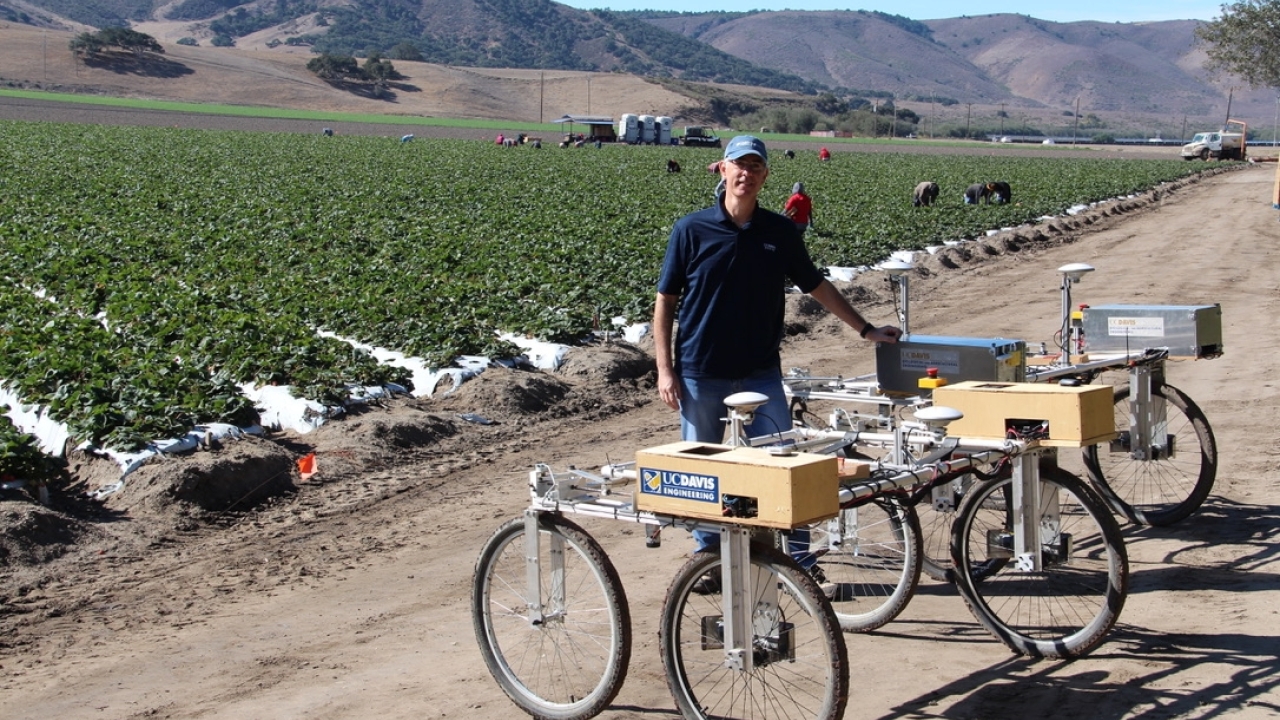Strawberry Harvesters Get Some Help from New Robot Coworkers
Strawberry season may be getting streamlined thanks to new robot coworkers developed at UC Davis.
Using an innovative prediction and scheduling system, Fragile cRop hArvest-aIding mobiLe robots, or FRAIL-bots, track the picking process of each worker so when they’re finished filling a tray with strawberries, a FRAIL-bot is already nearby to take it back to the collection station for them.
Efficiency during strawberry season is key for both workers and producers, as workers are typically paid by how much they pick in a day, and producers regularly deal with labor shortages.
Though periodically changing posture and walking is healthy, workers often need to walk hundreds of feet to and from the edge of the field every time they’re done harvesting. The team’s initial studies showed that having FRAIL-bots do this can save up to 25 percent more time, which would lead to greater pay and higher yield each season.
“This is a very advanced system that works in a radically different way than what’s out there,” said Biological and Agricultural Engineering Professor Stavros Vougioukas, who led the project. “It’s like if you want to go to the movies using Uber; if Uber knows you want to go, what time the movie starts and how long it takes from your house to get there, it could come to you without you needing to call it. Our system works in the same way.”
Working with Workers

FRAIL-bots work as a fleet, in conjunction with workers, to turn a strawberry field into a dynamic system. At its heart is a customized cart called an iCarrito, which holds a tray of clamshells that the workers fill with strawberries as they pick. Each iCarrito is equipped with a GPS and load cells that wirelessly send data and tell the algorithm, in real time, where the tray is and how full it’s getting.
The system can also infer the harvesting speed and moving speed of the iCarrito so it can predict when and where to send a FRAIL-bot to retrieve a full tray from each picker to bring it to the collection station at the edge of the field.
“You need to be proactive,” said Vougioukas. “For all the pickers, we know the weight, the position and the time, and we can also extract the moving speed of the cart from this position and the harvesting speeds. [With this], we know where they are and can predict where and when they will need tray transport service.”
Since some workers are naturally faster than others and the same worker won’t pick at the exact same pace every time, the algorithm runs hundreds of different scenarios for when each worker may be ready for service. It then combines them together to develop a near-optimal and robust service schedule and assigns FRAIL-bots using a similar method to how Uber assigns rides.
“You predict, then you come up with a schedule that’s immune to disruption,” he said. “If you schedule the robots assuming that your prediction is perfect, then you’re going to be off a lot of the time.”
Workers can also opt in or out of service by pressing a button on their iCarrito, which gives them the option to not work with the robots or take a break and walk. The system can also choose not to service certain workers if it would be inefficient—such as if they’re near the collection station already.
End of a Journey

The project began in 2013 and it took years to develop the hardware and software from scratch at UC Davis. Vougioukas says the project wouldn’t be possible without the work of former Ph.D. student Chen Peng, who developed a large part of the system for his thesis, and development engineer Dennis Sadowski, who did all of the fabrication and mechanical and electrical assembly.
The FRAIL-bots were finally deployed in a strawberry field in Lompoc, CA in 2020 and were met with rave reviews. Vougioukas says the workers enjoyed having robot coworkers and felt relieved that they didn’t have to walk long distances as often, though he notes that they haven’t been deployed long-term. The system has also attracted significant interest from companies, at least one of which is evaluating the technology as a commercial product.
“We were very happy because it was a long journey,” he said. “There were a lot of people who were involved in the design, implementation, fabrication and testing, so seeing the robots in action and doing something useful the way we envisioned it is a great satisfaction.”
Evolving the Technology
In spite of the success, Vougioukas says there’s still work to do. He eventually wants the FRAIL-bots to carry more than one tray at a time and visit multiple workers in a single deployment instead of simply going and coming back.
The team is currently working on a routine that gives equitable service to workers, helping the slower pickers more often so their pay comes closer to that of their faster counterparts. Vougioukas also wants to incorporate an ergonomics routine that tracks how long each worker has been picking and gives them an opportunity to walk after a certain period of time so they can take breaks and change their posture.
“The technology gives you those sliders that you can push around to incorporate such twists and changes and make it more efficient, more equitable or more equal,” he said.
Though the FRAIL-bots were developed for strawberry harvesting, Vougioukas sees the technology being applied to a wide range of crops, and says it’s already being evaluated for table grapes.
“The whole idea can be extended to anything that you harvest manually,” he said. “All of the crops that require you to travel back and forth between where you finished harvesting and the side of the field to deposit your tray could benefit from transportation.”




